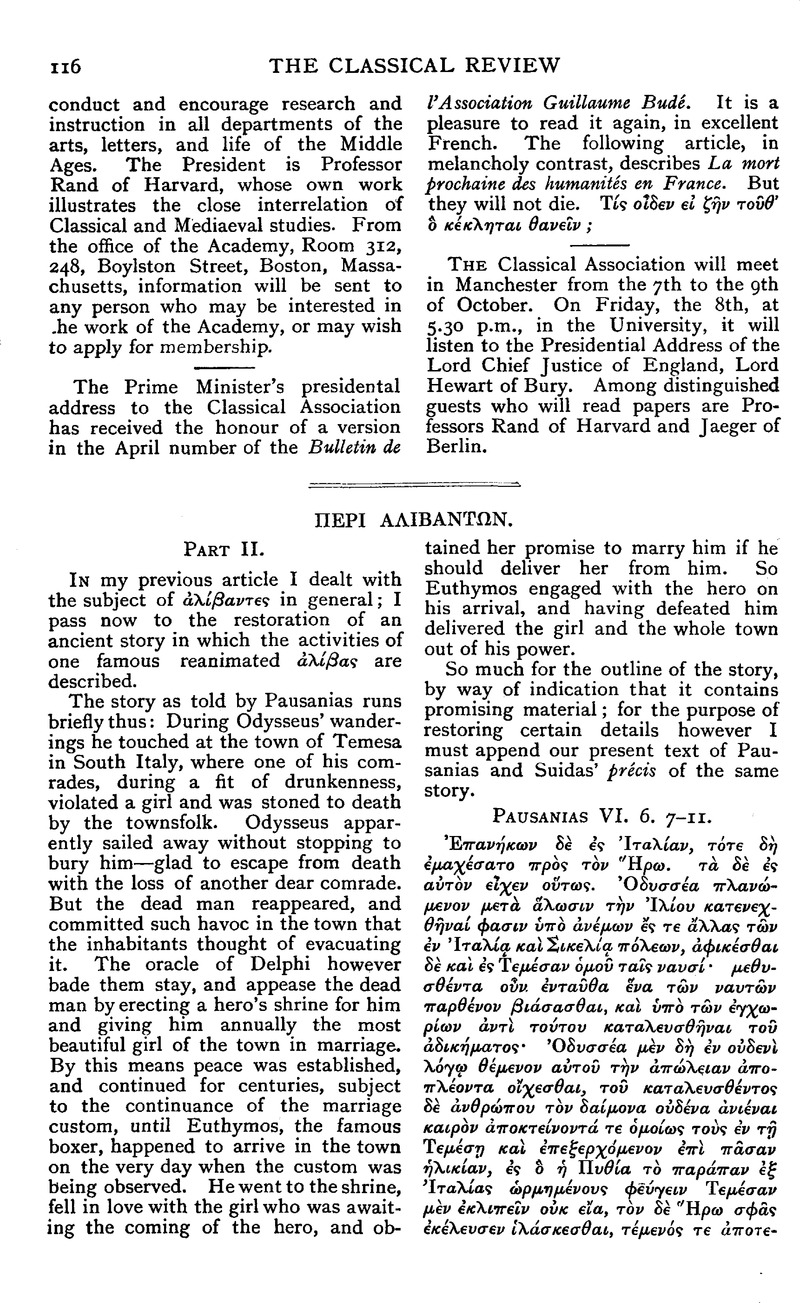No CrossRef data available.
Article contents
Abstract

- Type
- Review Articles
- Information
- Copyright
- Copyright © The Classical Association 1926
References
page 117 note 1 My text is that of the Teubner edition, save that I have omitted a comma after ![]() , and have bracketed
, and have bracketed ![]() .
.
page 117 note 2 Our existing MSS. are all of late date.
page 118 note 1 I rely for this statement on Benseler's edition of Pape, Wörterbuch der griech. Eigennamen.
page 118 note 2 The apparatus criticus in Hitzig's edition contains the following: ![]() codd. Ἀλ⋯βαντα e Suida voluit K(uhn) probante S(iebelis), sic vel Ἀλ⋯βαντα C(lavier), corr. B(ekker) Λ⋯καν τ⋯ ⋯π⋯. Hitzig himself, like other modern editors, perversely follows Bekker.
codd. Ἀλ⋯βαντα e Suida voluit K(uhn) probante S(iebelis), sic vel Ἀλ⋯βαντα C(lavier), corr. B(ekker) Λ⋯καν τ⋯ ⋯π⋯. Hitzig himself, like other modern editors, perversely follows Bekker.
page 118 note 3 S.v. ⋯λ⋯βας.
page 118 note 4 Etym. Magn. 579, 29; s.v. Μ⋯ταβος. Both spellings of the man's name are found together there. See the last paragraph of this article.
page 118 note 5 Strabo VI., p. 255, who is followed by Eustath. on Hom. Od. I. 185.
page 118 note 6 Agam. 1482.
page 118 note 7 Ibid. 1501 and 1508. For the connexion of the word μ⋯νις with ⋯λ⋯στορες and blood-guilt in general see my Mod. Greek Folklore, etc., pp. 447–449.
page 118 note 8 Paus. VI. 6. 10.
page 119 note 1 Mod. Greek Folklore, etc., p. 366.
page 119 note 2 Op. cit., p. 370.
page 119 note 3 Op. cit., p. 365; cf. pp. 367, 369, etc.
page 119 note 4 Philopseudes, 32.
page 119 note 5 Spectres (εἴδωλα) are also sometimes described as black ; cf. Dio Cassius, LXVII. 9. 2.
page 119 note 6 Menippus, 20.
page 119 note 7 Mr. A. B. Cook has kindly pointed out to me that on a South Italian vase (Naples 3249) Clytemnestra is depicted in black. Clytemnestra had every cause for returning as an ⋯λιβας, but the intention of the artist cannot be ascertained in this case; cf. note 5 above.
page 119 note 8 Cook, A. B., Zeus I., p. 99Google Scholar, where the Etruscan Hades is figured and the Greek evidence collected. I am indebted to Mr. Cook for calling my attention to this interpretation of the wolf-skin.
page 120 note 1 So also Hitzig and others.
page 120 note 2 Our text clearly includes one other gloss, viz. ⋯νθρώποις τοῖς ⋯ντα⋯θα, a mere explanation of the pronoun σφ⋯σιν. I have bracketed accordingly.
page 120 note 3 See my previous article.
page 120 note 4 Frazer, , Pausanias' Description of Greece. Vol. IV., p. 24Google Scholar.
page 120 note 5 See my previous article.
page 121 note 1 Eustath. in Od. XXIV. 304, p. 1961, 62.
page 121 note 2 Etym. Magn., s.v. Μ⋯ταβος, see note above on the Spelling of ⋯λ⋯βας. My attention was called to this by Pearson on Soph. Fr. 790.


